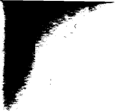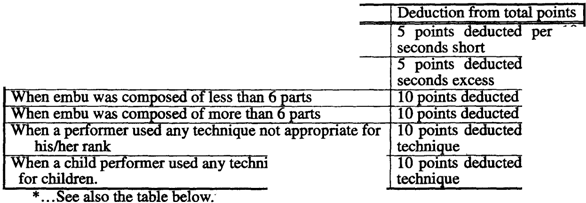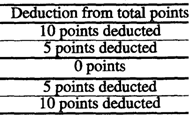|
|
|
Shorinji Kempo
Competition Rules |
|
Chapter I General Rules Article 1 Competition shall comply with the competition rules set forth by the Shorinji Kempo Federation. |
|
Article 2 The competitors shall conform to the principle of Shorinji Kempo, fully recognize its objectives, and remain fair throughout the performance. |
|
Chapter II Court Article 3 The court, in principle, shall be 7 by 7 meters in size. Article 4 The court shall be defined by while lines 5 to 10 centimeters in width. |
|
Chapter III . Clothing ArticleS The competitors shall wear Shorinji Kempo i (dogi) , which satisfy the "clothing regulations. " |
|
Article 6 The competitor shall not wear metal or other items that may be harmful to the opponent. |
|
Chapter IV Categories and methods of competition -Article 7 KumiEmbu 1. Kumi Embu shall be judged in terms of total points. 2. Embu shall be in freestyle but must consist of techniques designated for their rank. Competitors shall follow the "regulations regarding techniques designated for Bukai" and "regulations regarding techniques prohibited for Children's division." 3. An embu shall comprise 6 compositions, following the "regulations regarding composition of embu." 4. Embu shall last for at least 1 minute 30 seconds and up to 2 minutes; performance beyond these limits will cause demerit points and performance beyond 3 minutes disqualify the competitors. Embu by children shall last at least 1 minute up to 1 minute 30 seconds; performance beyond this limit will cause demerit points and performance beyond 2 minutes 30 seconds will disqualify the competitors. Group Embu Evaluated in the same manner as a lrumi embu. However, in a group embu only, all the performer of the group may perform the techniques designated for the highest rank holder of the group. |











